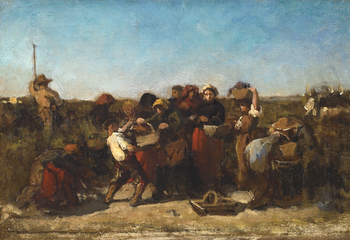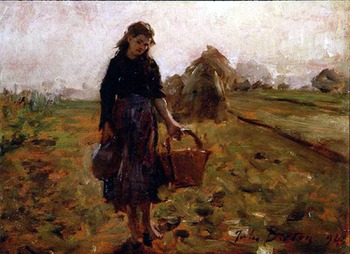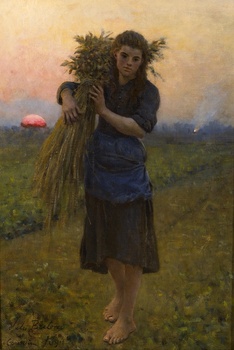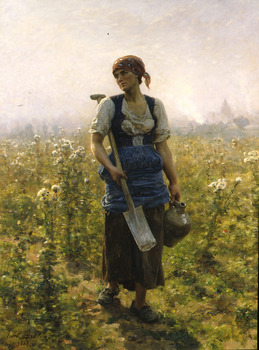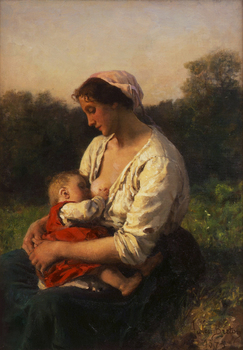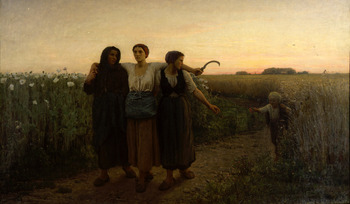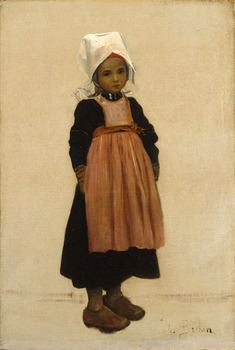Jules Breton
Jules Adolphe Breton was born on May 1, 1827 to a prominent family in the small village of Courrières in the Artois region of northern France. Although his mother died when Jules was only four, he grew up in a carefree and happy environment, with much of his time spent playing in the gardens and fields with the children of the village peasants, even though they were of a different social class.
At the age of ten, Breton was sent to school at a Catholic seminary, and three years later to the college of Douai, where he received a classical education. It was his first opportunity to study drawing and he acquired a love of poetry. In the summer of 1843, he so impressed the Belgian artist, Felix de Vigne, with his portraits and sketches after nature that the artist invited Breton to study with him in his studio as well as at the Royal Academy in Ghent. It was during this time that Breton honed his skill as a draughtsman. These studies continued for three years and gave him a chance to become familiar with the Flemish Old Masters. It was their simplicity and pure, unsullied sentiment that he tried to emulate in his first mature paintings.
In 1874 he went to Paris to complete his training under the tutelage of Michel-Martin Drolling at the Ecole des Beaux-Arts. A few months later Breton?s father became ill and died at Courrières. Breton left Paris to return home where the poor state of the family business interests forced the sale of the family furniture. At this time Breton began to feel a kinship with the local peasantry whom he had always loved, but with whom he had never really shared a social position. He began to paint subjects, which called attention to the plight of the poor and oppressed. It was with one of these paintings, Want and Despair (Misere et Desespoir) that he made his debut at the Salon of 1849.
By 1852, he focused his attention on landscape painting in the environs of Paris. However, an unimpressive showing at the Salon left him disheartened. The combination of discouragement and poor health caused Breton to return to Courrières. This move was a turning point in the evolution of the artist?s work. Leading a rustic life again awakened memories of a childhood spent playing in the fields and watching the peasants of the Artois region going about their labors. These memories of an idyllic rural life with their impressions of light and air became the foundation of his work and a source upon which he would draw for the rest of his career.
Breton?s first picture from this period was greatly admired at an exhibition in Brussels. At about this same time, he became engaged to Elodie de Vigne, the daughter of his former tutor. She posed frequently for him and was the model for the principal figure in The Gleaners, his first major composition of peasant life in Courrières. It was impressive enough, along with two other pictures, for the jury of the International Salon of 1855 to award him a third class medal.
Each year at the Salon his images of gleaners, harvesters and peasant women helped establish his reputation as the foremost painter of rural life. Along with several first class medals and, in 1872,the Medal of Honor, he was named a Chevalier of the Legion d?honneur in 1861, and in 1867 he was promoted to officer of the same order. His election to the Institut de France in 1886 solidified his status as one of the most respected painters of his day. This was the same year in which his painting, The Communicants, sold at auction in New York for $45,000, the highest price paid for the work of a living artist with the exception of a painting by Meissonier. In his later years, he became a prominent writer of poetry, as well as several autobiographies and critical works. Throughout his career, which spanned nearly sixty years, Breton painted with an idealistic vision of the beauty and harmony of the peasant laborer working the land. In tune with these thoughts, he lived a life of sober regularity - sure and balanced without serious conflict or great difficulty. He was respected by his peers for his intelligence, as well as his artistic and literary ability and achievements. His later years were spent balancing time between the busy energetic life of Paris and the tranquility and serenity of Courrières, where he worked in a garden studio at the family brewery. Breton died in Paris on July 4, 1906.
*We would like to thank Annette Bourrut Lacouture for providing this information.

